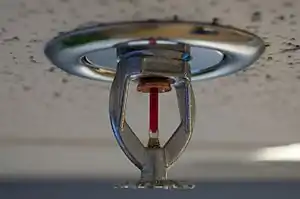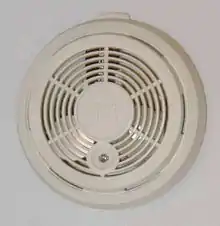Active fire protection
Active fire protection (AFP) is an integral part of fire protection. AFP is characterized by items and/or systems, which require a certain amount of motion and response in order to work, contrary to passive fire protection.
Categories of active fire protection
Manual fire suppression
Manual fire suppression includes the use of a fire blanket, fire extinguisher, or a standpipe system.
Fire blanket
A fire blanket is a sheet of fire retardant material that is designed to be placed over a fire to smother it out. small fire blankets are meant for inception stage fires. They are normally made of fiberglass or Kevlar.[1] Larger ones can be found in laboratories and factories, and are designed to be wrapped around a person whose clothes have caught fire.
Fire extinguisher
Fire extinguishers are one of the most common manual fire suppression devices and are required in all commercial buildings and vehicles.[2] Fire extinguishers can be used with little to no training and are meant for small incipient stage fires. The most common extinguisher is the ABC extinguisher and are found in most offices and homes. It can be used on normal fires, liquid fires, and electrical fires. There are also special extinguishers for kitchen fires and for use on burning metals.
Standpipe
Standpipes are installed in most large, multistory buildings. There are two types of standpipes: dry and wet. Most standpipes are dry systems and cannot be used by the public. Dry systems require a fire engine to pump water into the system. Most dry systems don't have pre-connected hoses and require firefighters to bring in the hose. In wet systems, there is always water in the pipes and they can be used by anyone. Wet systems will have hoses so building occupants can try and extinguish fires. Wet systems are becoming less common with the increase in number of sprinkler systems being installed.[3]
Automatic fire suppression
Automatic control means are any form of suppression that requires no human intervention these can include a fire sprinkler system, a gaseous clean agent, or Automatic foam suppression system. Most automatic suppression systems would be found in large commercial kitchens or other high-risk areas.

Sprinkler systems
Fire sprinkler systems are installed in all types of buildings, commercial and residential. They are usually located at ceiling level and are connected to a reliable water source, most commonly city water. A typical sprinkler system operates when heat at the site of a fire causes a fusible link or glass component in the sprinkler head to fail, thereby releasing the water from the sprinkler head.[4] This means that only the sprinkler head at the fire location operates – not all the sprinklers on a floor or in a building. Sprinkler systems help to reduce the growth of a fire, thereby increasing life safety and limiting structural damage.
Gaseous clean agent
Gaseous clean agents are installed in places where water or dry chemical extinguishing agents will do more harm than good. They are mostly installed in server or computer rooms where water or fine dust particles will cause vast amounts of damage. The system works by flooding an area with an inert or a mix of inert gasses to break the fire tetrahedron. Due to the inert gases displacing oxygen, there is a suffocation risk when it is activated. Most systems have a short delay to give people the opportunity to evacuate.
Foam suppression system
Automatic foam suppression systems come in three main forms low expansion, medium expansion, and high expansion.[5]
Low expansion
Low expansion foam expands less than 20 times its original size. These systems can be installed in a variety of places but are commonly found in places where hydrocarbons are stored. Low expansion foam systems when using film forming work by making a blanket of foam over the burning liquid to both cool it down and suppress the vapors.
Medium expansion
Medium expansion foam expands between 20 and 200 times its original size. These can be installed in outdoor settings like transfer stations or for use in open pits. Medium foam is used outdoors because it is denser than high expansion and won't blow away as easily. It works by covering what is on fire in a thick blanket of foam to smother it and suppress vapors.
High expansion
High expansion foam expands between 200 and 1000 times its original size. These systems are commonly installed in large volume areas like airplane hangars, mine shafts, and ship holds. These systems are normally installed inside and make a very light foam. They extinguish the fire by rapid smothering and cooling.[5] Its rapid rate of expansion enables it to fill large areas with foam rapidly. When used on LNG tanks they provide an added insulation layer that helps reduce the vapor rate.
Fire detection

Fire detection works using smoke or heat sensors. These systems are very effective tool at alerting people in the immediate vicinity of where the fire is detected but building regulations[6] require an integrated fire detection system. These system not only alerts people throughout the building by triggering the fire alarm but it can also summon emergency services. There are two types of systems available – addressable and conventional. Addressable systems monitor the specific location of each device (eg smoke detector, call point or sounder). It means in the event of a fire or other emergency you know exactly where the problem is. This saves precious time and helps the emergency services prevent the loss of life and serious damage. Conventional systems can only determine the problem is in a general area and thus are more suited for small sites.[7]
When the fire detection system is activated it can also send an alert to the local fire department, broadcast a prerecorded warning message and unlock the buildings access control system.
Hypoxic air fire prevention
Fire can be prevented by hypoxic air. Hypoxic air fire prevention systems, also known as oxygen reduction systems are new automatic fire prevention systems that permanently reduce the oxygen concentration inside the protected volumes so that ignition or fire spreading cannot occur. Unlike traditional fire suppression systems that usually extinguish fire after it is detected, hypoxic air is able to prevent fires. At lower altitudes hypoxic air is safe to breathe for healthy individuals.
Construction and maintenance
All AFP systems are required to be installed and maintained in accordance with strict guidelines in order to maintain compliance with the local building code and the fire code.
AFP works alongside modern architectural designs and construction materials and fire safety education to prevent, retard, and suppress structural fires.
References
- , "Fire blanket", issued 1953-04-24
- National Fire Protection Association. Technical Committee on Portable Fire Extinguishers. (2013). NFPA 10, Standard for portable fire extinguishers. National Fire Protection Association. ISBN 9781455905683. OCLC 841176546.
- McGrail, David M. (2007). Firefighting Operations in High-Rise and Standpipe-Equipped Buildings. PennWell Books. ISBN 9781593700546.
- , "Sprinkler head", issued 1953-10-09
- "Fire Fighting Foams". www.chemguard.com. Retrieved 2019-06-13.
- "SANS10400 Building Regulations".
- "Fire Detection Systems". Intellisec.
External links
- Treatise on Active and Passive Fire Protection from UK Government
- When Fire Strikes, Stop, Drop and... Sing? – Article about acoustic fire suppression, Scientific American, January 24, 2008
- Karlsruhe Institute of Technology (KIT) - Forschungsstelle für Brandschutztechnik
.jpg.webp)